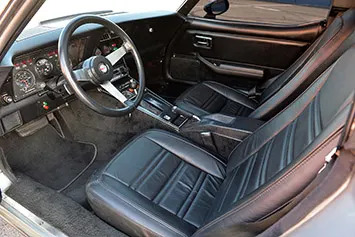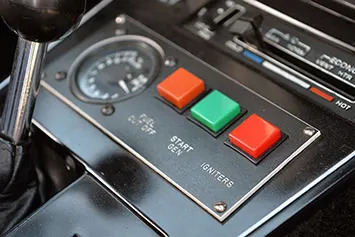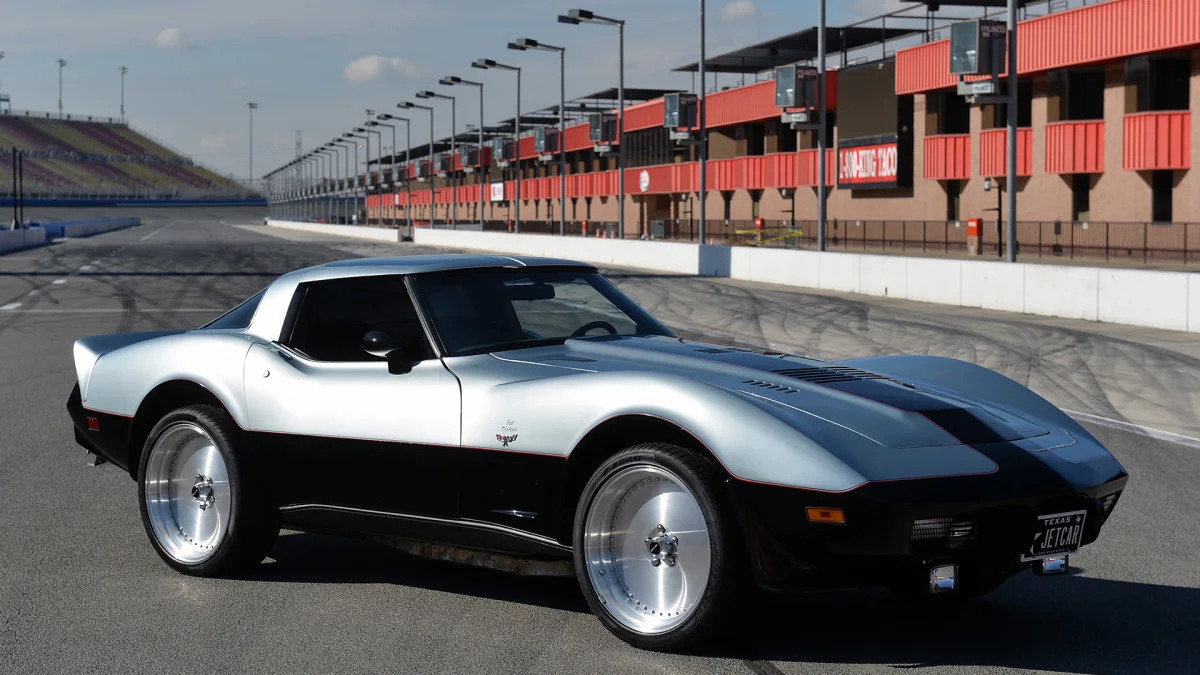-
EngineGas Turbine
-
Power880 HP / 1,161 LB-FT
-
Transmission3-Speed Automatic
-
0-60 Time3.2 Seconds (est)
-
DrivetrainRear-Wheel Drive
-
Engine PlacementFront
-
Seating2
With its curvy snout and feminine haunches, the third-gen Chevrolet Corvette looks like a dreamy – if dated – exemplar of Sports Car Fantasy 101 when viewed through modern eyes.
This particular specimen circa '78, clad in silver and black paint with red pinstripes, appears to be a well-preserved example from the era. Apart from its low-profile Pirellis, slightly raised and slotted hood, spacious stance and a certain hand-painted descriptor alongside its crossed flag logos, you'd never guess there's a Space-Age propulsion unit powering this Coke bottle-bodied ride.
Climb inside, and you're presented with aircraft gauges and big, colorful square buttons in the center panel. It takes a push of the "Ignitor" button, a tap of the starter button, and a slide of a T-handle for this nearly 40-year-old sports car to start sounding like Gulfstream G650 ready for takeoff. Yep, you're sitting in an 880-horsepower, turbine-powered Corvette, the only one of its kind in the world. Welcome to the whoosh.
What The...?
Built by Vince Granatelli, son of Indy 500 guru Andy Granatelli, this curious Corvette came into being by cramming a Pratt & Whitney ST6N-74 gas turbine engine into the donor car's lengthy front end. The same type of Jet A-burning mill powered Granatelli Senior's STP-sponsored racecar at the 1967 Indianapolis 500, where it famously led most of the 198 of 200 laps until a $6 transmission bearing failed, knocking it out of the race. The idea of turbine power usurping internal combustion was so threatening that Indy's governing body restricted turbine performance into obsolescence thereafter.
A turbine-powered Corvette sounds excessive because it is. But there are also things about this 880-horsepower, 1,161-pound-feet monster that might surprise you. While it smacks of futurist exoticism and cost a then-dizzying $37,000 in 1967, the Canadian-built powerplant uses 80 percent fewer parts than an internal combustion V8 and will run on virtually anything combustible – whiskey, diesel, even Chanel No. 5. Though it's triple the length of a V8, the Pratt & Whitney beast weighs only 285 pounds. It's also one hell of a robust workhorse, typically serving as an auxiliary power unit for commercial aircraft or a generator in oil fields, where it can run for tens of thousands of consecutive hours before needing an overhaul.

To adapt the Chevrolet for jet duty, the nose section was gutted and a sub-frame was built to compensate for the loosey-goosey front end. Granatelli installed large 1978-era NASCAR brakes to handle stopping duties, while the turbine's 37,500-rpm operating speed was trimmed to terrestrial levels via a reduction gearbox; at full throttle, engine output is 6,230 rpm. A reinforced three-speed Turbo 400 automatic transmission powers the beefed-up driveshaft, and a 3.03:1 rear end diverts torque to 20-inch Centerline wheels wrapped in modern Pirelli P-Zero rubber. A massive, bespoke exhaust system routes the turbine's spent gases to a rectangular box beneath the car, which is responsible for the car's aforementioned ride height. And then there's the instrumentation, which incorporates analog aircraft gauges (cool!) but places digital displays slightly off-center within cockpit-style frames (hmm...); the cabin is otherwise classic late 1970s Americana, with uncharismatic straight-edge surfaces that are an anathema to the exterior's Rubenesque proportions.
Clear For Takeoff
My seat time in the so-called Jet Vette was limited to two laps of the banked Auto Club Speedway course in Fontana, CA, with a watchful eye in the passenger seat making sure I didn't attempt my finest "Maverick" impersonation from Top Gun. We were instructed to wear helmets, which I did, yet my chaperone (who you can see in the video) oddly did not. The guided conditions and limited drive were no doubt attributable to the fact that the car was scheduled to cross the auction block a few weeks later. But the sense of occasion could hardly be dimmed: after all, few automotive sensations are quite as sexy as climbing into a car that sounds like a passenger jet ready for takeoff.




The Pratt & Whitney ST6 idles at a minimum 62-percent throttle, which causes quite the decibel-intensive, whistle-like racket. It's still somewhat loud within the cabin, though not as piercing as you might expect; I was able to carry a conversation with my right-seat minder, albeit at heightened volume levels. The Corvette's heavy-duty brakes are crucial to the car's day-to-day operation for reasons which become obvious when you click the shifter into "D": the car lurches forward a tad no matter how hard you're pressing the left pedal, revealing the turbine's intense state of rest, even when running at 62 percent. Let off the brake, and the Corvette accelerates with leisurely authority to around 60 mph – and that's without touching the throttle. Lay into it, as Motor Trend did in a 1979 track test, and you should be able to sprint to 60 mph in 3.2 seconds, even quicker if you believe Mr. Granatelli's estimations. The ride feels somewhat firm along the Speedway's smooth tarmac, though it's certainly not punishing; the car's tendency to hum along at its own speed makes it feel eerily like a runaway train of sorts, like it couldn't care less if anything comes in its way.
With a gentle press of the accelerator while cruising at idle, the high-pitched whine rises even higher, making the banked oval feel more like a runway than a racetrack. Interestingly, acceleration isn't instantaneous; there's a perceptible kickdown from the transmission and it takes about three seconds before the thrust gently but noticeably pushes you back into your leather-wrapped bucket seat. Just before it feels like you might build up enough lift for takeoff, the gentleman in the right seat asks you to slow down, which later inspires speed-fueled fantasies involving horizonless dry lake beds and an afternoon spent chasing the sun.

The turbine settles back down to idle with just as sexy a whine as it makes when it's winding up, and after two quick laps, it's time to firmly press the brake and bring it back into the pits. Clicking the shifter lever back to "P" finally abates the runaway train feeling with a slight jerk.
It's been nice knowin' ya, Jet Vette; until never again, most likely.
Date With Destiny
If its reserve minimum is met, the turbine-powered Corvette will find its next owner at Barrett-Jackson's Scottsdale auctions on January 17, 2014, along with the just-restored STP-sponsored 1968 Lotus 56-3 racecar. Current owner Milton Verret looks back fondly on his time with both turbine cars, the former which he has driven roughly a thousand miles since he bought it in 1982. Verret is no stranger to vehicular excess (and Americana, in particular): he also owns a panoply of Corvettes and Camaros, as well as the Ecto-1 from Ghostbusters, and John Lennon's 1956 Austin Princess used in the Imagine documentary.
What's it like for the Texas-based gearhead to let go of his prized jet-powered possessions? "I'm sitting here kind of stunned, to be honest," Verret told me prior to my test drive. His incredulity was fitting, considering the cars' rarity and exceptional personalities. "After doing all the press," he said, "it's like, God, what am I doing?"
This particular specimen circa '78, clad in silver and black paint with red pinstripes, appears to be a well-preserved example from the era. Apart from its low-profile Pirellis, slightly raised and slotted hood, spacious stance and a certain hand-painted descriptor alongside its crossed flag logos, you'd never guess there's a Space-Age propulsion unit powering this Coke bottle-bodied ride.
Climb inside, and you're presented with aircraft gauges and big, colorful square buttons in the center panel. It takes a push of the "Ignitor" button, a tap of the starter button, and a slide of a T-handle for this nearly 40-year-old sports car to start sounding like Gulfstream G650 ready for takeoff. Yep, you're sitting in an 880-horsepower, turbine-powered Corvette, the only one of its kind in the world. Welcome to the whoosh.
What The...?
Built by Vince Granatelli, son of Indy 500 guru Andy Granatelli, this curious Corvette came into being by cramming a Pratt & Whitney ST6N-74 gas turbine engine into the donor car's lengthy front end. The same type of Jet A-burning mill powered Granatelli Senior's STP-sponsored racecar at the 1967 Indianapolis 500, where it famously led most of the 198 of 200 laps until a $6 transmission bearing failed, knocking it out of the race. The idea of turbine power usurping internal combustion was so threatening that Indy's governing body restricted turbine performance into obsolescence thereafter.
A turbine-powered Corvette sounds excessive because it is. But there are also things about this 880-horsepower, 1,161-pound-feet monster that might surprise you. While it smacks of futurist exoticism and cost a then-dizzying $37,000 in 1967, the Canadian-built powerplant uses 80 percent fewer parts than an internal combustion V8 and will run on virtually anything combustible – whiskey, diesel, even Chanel No. 5. Though it's triple the length of a V8, the Pratt & Whitney beast weighs only 285 pounds. It's also one hell of a robust workhorse, typically serving as an auxiliary power unit for commercial aircraft or a generator in oil fields, where it can run for tens of thousands of consecutive hours before needing an overhaul.

To adapt the Chevrolet for jet duty, the nose section was gutted and a sub-frame was built to compensate for the loosey-goosey front end. Granatelli installed large 1978-era NASCAR brakes to handle stopping duties, while the turbine's 37,500-rpm operating speed was trimmed to terrestrial levels via a reduction gearbox; at full throttle, engine output is 6,230 rpm. A reinforced three-speed Turbo 400 automatic transmission powers the beefed-up driveshaft, and a 3.03:1 rear end diverts torque to 20-inch Centerline wheels wrapped in modern Pirelli P-Zero rubber. A massive, bespoke exhaust system routes the turbine's spent gases to a rectangular box beneath the car, which is responsible for the car's aforementioned ride height. And then there's the instrumentation, which incorporates analog aircraft gauges (cool!) but places digital displays slightly off-center within cockpit-style frames (hmm...); the cabin is otherwise classic late 1970s Americana, with uncharismatic straight-edge surfaces that are an anathema to the exterior's Rubenesque proportions.
Clear For Takeoff
My seat time in the so-called Jet Vette was limited to two laps of the banked Auto Club Speedway course in Fontana, CA, with a watchful eye in the passenger seat making sure I didn't attempt my finest "Maverick" impersonation from Top Gun. We were instructed to wear helmets, which I did, yet my chaperone (who you can see in the video) oddly did not. The guided conditions and limited drive were no doubt attributable to the fact that the car was scheduled to cross the auction block a few weeks later. But the sense of occasion could hardly be dimmed: after all, few automotive sensations are quite as sexy as climbing into a car that sounds like a passenger jet ready for takeoff.




The Pratt & Whitney ST6 idles at a minimum 62-percent throttle, which causes quite the decibel-intensive, whistle-like racket. It's still somewhat loud within the cabin, though not as piercing as you might expect; I was able to carry a conversation with my right-seat minder, albeit at heightened volume levels. The Corvette's heavy-duty brakes are crucial to the car's day-to-day operation for reasons which become obvious when you click the shifter into "D": the car lurches forward a tad no matter how hard you're pressing the left pedal, revealing the turbine's intense state of rest, even when running at 62 percent. Let off the brake, and the Corvette accelerates with leisurely authority to around 60 mph – and that's without touching the throttle. Lay into it, as Motor Trend did in a 1979 track test, and you should be able to sprint to 60 mph in 3.2 seconds, even quicker if you believe Mr. Granatelli's estimations. The ride feels somewhat firm along the Speedway's smooth tarmac, though it's certainly not punishing; the car's tendency to hum along at its own speed makes it feel eerily like a runaway train of sorts, like it couldn't care less if anything comes in its way.
With a gentle press of the accelerator while cruising at idle, the high-pitched whine rises even higher, making the banked oval feel more like a runway than a racetrack. Interestingly, acceleration isn't instantaneous; there's a perceptible kickdown from the transmission and it takes about three seconds before the thrust gently but noticeably pushes you back into your leather-wrapped bucket seat. Just before it feels like you might build up enough lift for takeoff, the gentleman in the right seat asks you to slow down, which later inspires speed-fueled fantasies involving horizonless dry lake beds and an afternoon spent chasing the sun.

The turbine settles back down to idle with just as sexy a whine as it makes when it's winding up, and after two quick laps, it's time to firmly press the brake and bring it back into the pits. Clicking the shifter lever back to "P" finally abates the runaway train feeling with a slight jerk.
It's been nice knowin' ya, Jet Vette; until never again, most likely.
Date With Destiny
If its reserve minimum is met, the turbine-powered Corvette will find its next owner at Barrett-Jackson's Scottsdale auctions on January 17, 2014, along with the just-restored STP-sponsored 1968 Lotus 56-3 racecar. Current owner Milton Verret looks back fondly on his time with both turbine cars, the former which he has driven roughly a thousand miles since he bought it in 1982. Verret is no stranger to vehicular excess (and Americana, in particular): he also owns a panoply of Corvettes and Camaros, as well as the Ecto-1 from Ghostbusters, and John Lennon's 1956 Austin Princess used in the Imagine documentary.
What's it like for the Texas-based gearhead to let go of his prized jet-powered possessions? "I'm sitting here kind of stunned, to be honest," Verret told me prior to my test drive. His incredulity was fitting, considering the cars' rarity and exceptional personalities. "After doing all the press," he said, "it's like, God, what am I doing?"










Sign in to post
Please sign in to leave a comment.
Continue